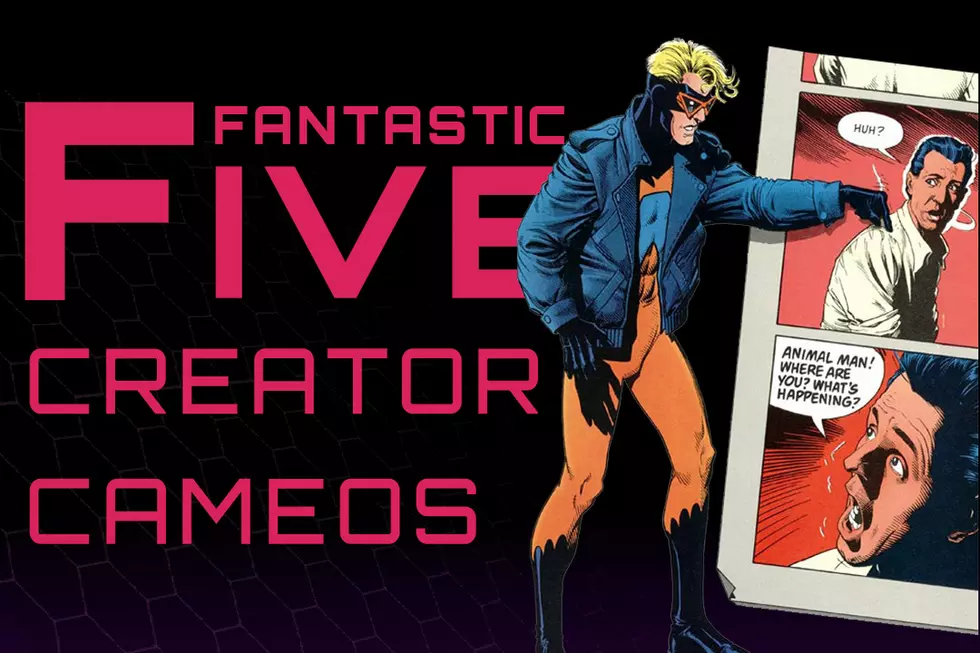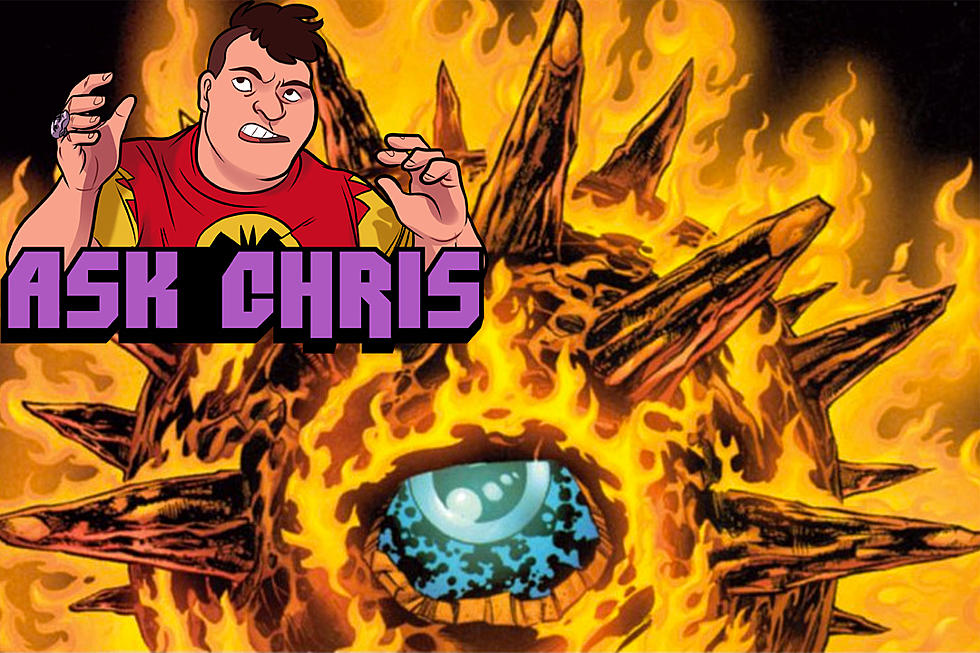
How Jack Kirby’s Art Helped the CIA Rescue Diplomats in 1979

I don't think I'm overstating things when I say that I'm a pretty big fan of Jack Kirby, the legendary artist who co-created Captain America, Thor, the Avengers, the Marvel Universe, romance comics, and... well, pretty much everything in modern comic books except the staples. He's my all-time favorite. I've got a ton of Kirby comics, and I've even got a full set of the trading cards they made of his unproduced animation concepts that he worked on in the '80s.
That's why I was so surprised that I'm apparently one of the last people on Earth to find out about Kirby's connection to a CIA operation to extract six diplomats from Iran during the famous hostage crisis of 1979 -- and even more so when I found out from my pal Chad Bowers when he found out because Michael Parks, the guy who played the aviator-sporting sheriff in Kill Bill had been cast as Kirby in an upcoming movie directed by Ben Affleck about the whole affair. Either way, I'm glad I did, because it turns out to be one of the strangest and most fascinating real-life stories I've ever heard.Then again, you may have heard this story before. It made a few headlines back in 2007, when the CIA released a compelling retrospective from one of the men behind the operation, Antonio J. Mendez. It was also covered in an extensive piece in Wired and, of course, The Jack Kirby Collector. There's a good reason for all the attention, and it all starts with Roger Zelazny.
 Like most of the things in this story, Zelazny sounds like he stepped straight out of a comic book. Not only was he an award-winning science fiction novelist with a Hugo award under his belt, he was also a expert fencer and martial artist who had studied eight different fighting styles and would later take up teaching Aikido when he wasn't writing. Seriously, the most amazing thing about this story is that with all that under his belt, he doesn't turn out to be a spy himself at the end of it.
Like most of the things in this story, Zelazny sounds like he stepped straight out of a comic book. Not only was he an award-winning science fiction novelist with a Hugo award under his belt, he was also a expert fencer and martial artist who had studied eight different fighting styles and would later take up teaching Aikido when he wasn't writing. Seriously, the most amazing thing about this story is that with all that under his belt, he doesn't turn out to be a spy himself at the end of it.
In 1967, Zelazny published Lord of Light, and by all accounts, it's a pretty complex book. Set up a series of events related out of chronological order, it's the story of a group of colonists in the distant future who have abandoned Earth in search of a new home planet, and in the process developed a way to give themselves super-powers and transfer their minds into new bodies through a sort of technological reincarnation. As a result, they were able to establish themselves as the absolute masters of an alien world, taking the names and roles of Hindu gods and instituting a class system, until one of their number -- Sam -- decided that everyone should be allowed to have powers and introduced Buddhism to outer space. Also, according to Wikipedia, "two characters engage in a contest of 'Irish Stand-down,' in which they take turns punching each other until one collapses."
In other words, it sounds like the best book ever, even if I needed a plot summary of the plot summary. And apparently I'm not the only one to think so: Lord of Light earned Zelazny the second of his six Hugo awards.
 And a decade later, Lord of Light would catch the eye of Barry Geller. At the time, sci-fi had become huge in American pop culture in a way that it never really had before. The year before, an obscure young director had made a movie with a cast of unknowns, plus one veteran mostly known for British vampire movies and exactly one Academy Award-winning actor that he killed off halfway through the film, and people lost their minds. Calling it a massive success would've been the understatement of the century -- it's 35 later and people are still flipping out about it. Me, I think it all came down to that catchy title. "Star Wars" is pretty hard to beat.
And a decade later, Lord of Light would catch the eye of Barry Geller. At the time, sci-fi had become huge in American pop culture in a way that it never really had before. The year before, an obscure young director had made a movie with a cast of unknowns, plus one veteran mostly known for British vampire movies and exactly one Academy Award-winning actor that he killed off halfway through the film, and people lost their minds. Calling it a massive success would've been the understatement of the century -- it's 35 later and people are still flipping out about it. Me, I think it all came down to that catchy title. "Star Wars" is pretty hard to beat.
So Geller bought the film rights to Lord of Light, presumably planning to ride that surge of sci-fi popularity to new heights. He wrote a treatment, raised some money, and in order to bring Zelazny's ideas to life, he hired an artist that was already a huge name in science fiction circles: Jack Kirby.
When he was approached by Geller, Kirby was on his way out of doing comics full-time, having grown dissatisfied with the treatment from an industry he'd been instrumental in building. He never stopped doing comics -- and produced some of his best comics work a few years later in the form of the Hunger Dogs graphic novel -- but at the time he was moving into producing concepts for Ruby-Spears animation.
As a result, he was a good fit for the project, and Geller put him in charge of doing all the designs for the film:


Kirby's designs are his typical (which is to say amazing) work, but there's one thing about them that makes them even more fascinating than your average unproduced Kirby piece, and it's the same thing that makes me pretty comfortable in my assumption that Geller wanted to ride that post-Star Wars sci-fi boom to financial success.
See, Geller didn't just want to make a movie. He wanted to make a theme park.

It was called Science Fiction Land, and Geller's plan for it was absolute genius. He'd build the sets for his proposed $50,000,000 movie -- and keep in mind, that's in 1978 dollars -- and then turn the actual sets themselves into the theme park and the rides, all built around a sci-fi theme, in (of all places) Aurora, Colorado. And it almost happened, too.
In fact, plans for the movie got so far along that they even had a potential star in the form of Rosey Grier, another dude who sounds like he just stepped out of a comic. He rose to fame as a member of the NFL's "Fearsome Foursome" on the LA Rams, worked as a bodyguard for Robert Kennedy (he's the one who stopped a the crowd from attacking Kennedy's assassin, Sirhan Sirhan, because he didn't want to see any more violence), and later released a book called Rosey Grier's Needlepoint For Men. And along the way, he was also an actor, having starred in the Blaxploitation comedy The Thing With Two Heads.
Unfortunately for Geller, Grier, Kirby and everybody else who wanted to live in a world with a theme park designed by Jack Kirby, the film fell through when it was discovered that a member of Geller's production team had been embezzling funds from the movie's budget. The project never recovered, and while Kirby's designs are still being sold as prints, we never got the real SciFiLand.
But here's where the story takes a twist. On November 4, 1979, the American embassy in Tehran was taken over. 52 diplomats were taken prisoner in the Iran hostage crisis, but six managed to escape, secretly taking refuge with the Canadian embassy. This is where Mendez enters the story, as one of the CIA operatives who was tasked with coming up with a plan to extract the six diplomats who were still unknown to the others.
The first suggestions were exactly the sort of "sneak in under the cover of darkness" type operations that you'd expect, including one involving a secret route to Turkey once used by former Presidential candidate Ross Perot to get two of his employees out of the country. In the end, though, Mendez settled on doing something that was the exact opposite of secrecy, to the point where he even announced his plans in newspapers.

Of course, he didn't announce that it was a CIA operation. He set up a fake production company called "Studio Six Productions" and took out ads in Variety and The Hollywood Reporter announcing the production of a brand new science fiction blockbuster called Argo, complete with the Kirby-esque tagline "A COSMIC CONFLAGRATION." The plan was to establish a team with the cover story of a Canadian film crew scouting locations in the Middle East for their film. After all, Star Wars had been shot in Tunisia, so why wouldn't the makers of Argo go for a location equally as exotic?
The only thing Mendez needed was a script, and for that, Mendez called his friend John Chambers -- best known as the makeup artist for another sci-fi hit, 1969's Planet of the Apes -- who provided him with an unproduced script that he'd had laying around ever since its producers approached him to do work on it before the whole thing fell through.
The script Chambers brought to Mendez was perfect. Not only was it a sci-fi picture with the mythological elements Mendez wanted, but -- according to Mendez -- it was so complex that it would be incomprehensible to anyone who searched. It was exactly the sort of thing they needed: plausible and authentic with the added touch of concept art from "a famous comic-strip artist," but so dense that nobody would want to take a closer look at the script. So they used it.
Thus, Lords of Light and its Jack Kirby production designs became Argo, a fake name for a fake movie produced by a fake company for the purpose of getting diplomats out of a hostage crisis. With Argo as their cover, Mendez assigned roles in the production crew to the six diplomats, turning them all into actors by necessity. As he writes in his article for CIA.gov:
They had scrounged clothes from one another and restyled their images to look more "Hollywood." Each of them was having great fun playing their part and hamming it up. The most dramatic change was made by the rather distinguished and conservative Bob Anders. Now, his snow-white hair was a "mod" blow dry. He was wearing tight trousers with no pockets and a blue silk shirt unbuttoned down the front with his chest hair cradling a gold chain and medallion. With his topcoat resting across his shoulders like a cape, he strolled around the room with the flair of a Hollywood dandy.
It might seem strange to think about people in such a tense situation having fun pretending to be Hollywood actors, but after a month of hiding secretly with the Canadians -- who would decide within days of the Argo operation to shut down their own embassy and get out of Tehran before they were overrun themselves -- breaking the tension is downright necessary.
And it was tense, especially once Mendez let his group to the airport, where they were booked to fly to Switzerland before their return to "Hollywood." As reported by Wired, the plan was to get to the airport and fly out before 10 AM, when the Iranian Republican Guard would show up to start dealing with the chaos of people trying to leave the country, only to find that their flight had, of course, been delayed:
The wait was agonizing. Everyone kept their heads down. Joe Stafford picked up a local paper at one point and then remembered that Canadian film crews don't read Farsi. He also kept using people's real names, giving the others serious jitters. It was getting later and brighter. The airport was filling with people. They knew there was no backup plan. Mendez wasn't even carrying a gun, and the Revolutionary Guards were arriving, wandering around in fatigues and harassing passengers. Look them in the eye, Mendez had coached the six in case anyone was questioned. Be confident but seem innocent. But he knew from the agency's reconnaissance that the guards could be tough, even subjecting people to sudden body cavity searches. A mechanical problem caused a delay, and the Revolutionary Guards were starting to turn their attention to foreign passengers.
Mendez disappeared. He had a contact at the airport and went to check on the flight status. No sooner had he learned that the delay would be short than they heard the announcement: "Swissair flight 363, ready for immediate departure." As they boarded the plane from the windy tarmac, Anders noticed the word AARGAU was printed across the fuselage - the name of the Swiss region where the plane originated was strangely similar to that of their cover story. He punched Mendez's arm and said, "You guys arrange everything, don't you?"
In the end, it all worked. The cover, bolstered by the authenticity of Geller's script and Kirby's designs, held up, and on January 28, 1980, the six diplomats that had escaped the hostage crisis returned to America, with great fanfare about how Canada had stepped in to rescue a handful of diplomats from what would become a 444-day hostage crisis.
It's a thrilling story, full of twists and bizarre moments -- according to Mendez, his fake production company even got a script from Steven Spielberg while they were pulling off the rescue -- and for all the international tension that still lingers, this part at least had a happy ending.
Well. As happy as it can be in a world where the Jack Kirby theme park doesn't exist, anyway.
More From ComicsAlliance




![Super7 ReAnimates Alien and Predator, Masters More of the Universe [Toy Fair 2017]](http://townsquare.media/site/622/files/2017/02/IMG_2000.jpg?w=980&q=75)

![The Wild, Tear-Filled World of Heartbreak: The Best Romance Comic Covers Ever [Love & Sex Week]](http://townsquare.media/site/622/files/2017/02/featured1.png?w=980&q=75)


